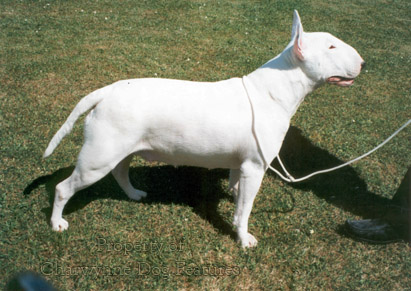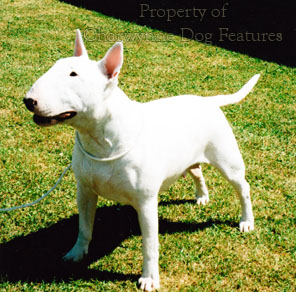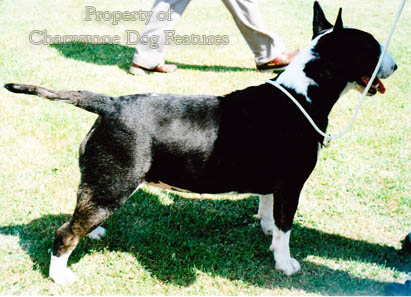560a Promoting real bull terriers
PROMOTING THE REAL BULL TERRIER
by David Hancock
 In an article headed 'Making a Difference for Pedigree Dogs', in the Kennel Gazette of August 2006, the KC claimed that: 'With the acquisition of a pedigree dog you receive: Predictability- owners know what to expect from their dog with regard to appearance such as (sic) size and coat type. ' It didn't claim a much more important feature which should be guaranteed by pure breeding: that the dog should look like its ancestors. Do today's breeds of Mastiff, Bulldog and Bull Terrier look like their prototypal ancestors? I think not. Most breeds do, length of coat, back, legs, ears and jaw apart! This is surely a vital role for a registry, ensuring the honesty of the product. And a diligent lawyer might one day spot this. In the Kennel Gazette of December 2005, the chairman of the KC quoted the chairman of one breed club as saying: 'I've been in this job for over twenty years now and I really wonder if the breed has actually improved in that time. ' But shouldn't the KC be keeping the breeds and the canine registry honest?
In an article headed 'Making a Difference for Pedigree Dogs', in the Kennel Gazette of August 2006, the KC claimed that: 'With the acquisition of a pedigree dog you receive: Predictability- owners know what to expect from their dog with regard to appearance such as (sic) size and coat type. ' It didn't claim a much more important feature which should be guaranteed by pure breeding: that the dog should look like its ancestors. Do today's breeds of Mastiff, Bulldog and Bull Terrier look like their prototypal ancestors? I think not. Most breeds do, length of coat, back, legs, ears and jaw apart! This is surely a vital role for a registry, ensuring the honesty of the product. And a diligent lawyer might one day spot this. In the Kennel Gazette of December 2005, the chairman of the KC quoted the chairman of one breed club as saying: 'I've been in this job for over twenty years now and I really wonder if the breed has actually improved in that time. ' But shouldn't the KC be keeping the breeds and the canine registry honest?
All over Britain, there are artisan breeders at work striving to restore to us some of our precious breeds of dog, altered, you could say disfigured by show-ring excesses. The working Clumber Spaniel is much more like the orginal breed than the show ring dogs. The Victorian, Dorset and Sussex Bulldogs are much more like the classic English breed than any current show- ring specimen. Now, Lyndon Ingles of Tredegar in Gwent is producing real Bull Terriers, just like the unexaggerated athletic specimens of the late 19th and early 20th centuries. I do hope his admirable endeavours receive the support they deserve.
We once had a breed of dog, created here in Britain but eventually known throughout the British Empire, admired for its bravery, respected for the staunchness of its character, revered for its indomitable spirit and popular, not just because of these qualities, but because it was also robust, unexaggerated, sensibly constructed and stable in temperament. Once its dogfighting ancestry had been bred out, this breed, the Bull Terrier, became a great deal more than the 'Bill Sykes' character of the dog world, with its blood being utilised to inject perseverance into other breeds from the heelers of Australia to the hunting mastiffs of Argentina. 
James Hinks of Birmingham is generally regarded as the creator of the all-white Bull Terrier at the end of the 19th century, with his sons continuing his work. It had however been the practice of working terrier enthusiasts to outcross their dogs to the Bulldog every fifth generation or so to instil gameness.
Some early Bull Terrier breeders are also alleged to have used. Whippet and Pointer blood to achieve the desired conformation. No breeder wanted his dogs to be called bulldoggy or whippety and so the shape of the skull assumed importance. The Bull Terrier produced by Hinks was a good-looking active athletic dog, strong-headed but without exaggeration in any feature, a symmetrical, well-balanced canine athlete, still very terrier-like. His product in time gained admiration all over the world. The description of the Bull Terrier in 1896 produced by its breed club, established nine years earlier, used these words to describe the head: "...should be long, flat, and wide between the ears, tapering to the nose, without cheek-muscles. There should be a slight indentation down the face, without a 'stop' between the eyes." Winning dogs at the early shows featured heads roughly answering this description. A definite type emerged, based on a balanced head, a determined eye, a strong jaw and overall symmetry.
Sketched by Arthur Wardle in the 1890s, the breed had a confident, athletic, self-assertive look about it, with the head of what might be termed a strong terrier. In his "The Illustrated Book of the Dog" of 1880, Vero Shaw described the head of the Bull Terrier as: "...flat, wide between the ears, and wedge-shaped; that is, tapering from the sides of the head to the nose; no stop or indentation between the eyes is permissable, and the cheekbones should not be visible." Prophetically, Vero Shaw complained about judges, stating that ".. .we see, show after show, dogs gaining prizes in these classes which do not show one atom of Terrier character in their composition"...going on to describe them as "cow-faced wretches".
The breed prospered, despite the harm inflicted on so many breeds by the Great War. Then, in the late 1920s, the wording of the breed standard regarding the head changed quite dramatically. The Bull Terrier's head was suddenly expected to appear "oval, almost egg shape" with a profile "...almost an arc from the occiput to the tip of the nose. The more down- faced the better". For the first time in the long history of the dog, a breed was required to have an egg-shaped head. The reason for such a unique and unprecedented feature has never been stated. The Bull Terrier already had a clear identity and an established type when this rewording was agreed, so it could not have been to create a prototype.
Perhaps cynically, one can detect the hand of either one wealthy dominant breeder, or a clique of leading fanciers at that time, anxious to promote a certain shape of skull developing in their stock. Writing on the Bull Terrier before the Second World War, Hogarth described the foreface with this analogy: "...the curve of the profile should be 'Roman', as in, say, the Border, Leicester and Cheviot breeds of sheep." So we now had a redoubtable British breed of dog, renowned all over the world for its guts and gameness, needing to have its head resembling that of a sheep. Why a breed created from a blend of Bulldog and terrier should suddenly need a fore face like a sheep has never been explained. But if you took a pedigree Bull Terrier into a contemporary show ring without an egg-shaped head, you'd be laughed out of the ring. 
The breed standard of the Bull Terrier, as authorised by the Kennel Club today, now includes under "characteristics" these words: ".. .A unique feature is a downfaced, eggshaped head." This so-called unique feature was a fancier-insertion, an alien feature desired by show breeders. Such an absurd shape did not characterise the prototypal dogs; James Hinks, his sons and other early breeders such as Shirley, Adcock, Hartley and Ryder would be greatly ashamed to see their dogs betrayed in this way.
Tom Horner, who knew as much about Bull Terriers as anyone in the 20th century, has written on this subject: "The filled-up downfaced head is individual to Bull Terriers...No one knows exactly how it came into the breed, Hink's original white did not have it..." In other words, it never was an original feature of the breed. It is an old tactic to invent new words in order to blur issues or try to justify the unjustifiable. The word "downface" has no meaning; it was coined to legitimise an uncharacteristic undesirable feature which developed in this breed. Horner also wrote: ..."On balance it seems likely that the filled-up downface is the product of skilled breeding..." I am not sure that it wasn't the product of unskilled breeding by those without the talent of James Hinks and afraid to outcross to remove a strong alien feature cropping up in their stock. Far easier (and defeatist!) to authorise it! Then along comes the Kennel Club and legalises it!
The simple fact is that this "downface" should never have been allowed to develop in this quite admirable breed; it disfigures a famous breed, it attracts ridicule from the general public, it detracts from the symmetry and athleticism desired in such a breed and its mere existence exposes a breach of the original standard laid down by those who first developed this distinguished breed. The facts are that it is an untypical exaggeration, that all exaggerations end up exaggerating themselves and that, in time, the head of the breed will look quite monstrous. 
The dog-owning public is coming to its own conclusion. In 1972, there were twice as many Staffordshire Bull Terriers registered as there were Bull Terriers; in 1988 there were three times as many; in 1998 and in 2006 there were four times as many. The well-being and conservation of our precious native breeds of dog, part of our national heritage, is far too important a matter to be left in the hands of breed-point faddists. Every breeder of pedigree dogs should keep in his mind the words of the great foxhound breeder 'Ikey' Bell, in his "The Foxhound's Prayer":
"Remember that your stewardship
Spells trustee to our race.
The duty now before you
Is not to 'mess us up',
And not go running riot
To gain some silver cup."
At 'alternative' dog shows, unlicensed by the KC, I see what are termed 'Irish Staffies' and they look exactly like the old prints of our renowned Bull Terrier. They are usually owned by robust characters, who don't set much store on conforming -- just as Bull Terrier owners didn't in the 19th century. The Staffordshire Bull Terrier was established by fanciers who wanted to conserve their preferred type of Bull Terrier. Our English Bull Terrier is a very special native breed and it has been ruined by a bunch of misguided show breeders, who have no regard for the breed's classic physique and truly typical head. How can any rational person, especially an alleged lover of that breed, justify the imposition of a sheep's head on a dog's body? It isn't traditional; it isn't an improvement, if anything it is a deformation, a disfigurement. It is an outrageous liberty taken by faddists and condoned by the KC. Any admirer of our native breeds of dog, especially one as characterful as this one, should frown when they see this travesty, this parody being paraded as the real thing. Come on, terriermen of Britain, support the admirable Lyndon Ingles of Tredegar and champion the real Bull Terrier. 
Commendably, the KC has started to monitor championship show judges to ensure they are looking out for 'potentially damaging exaggerations', with the breeds of Bloodhound, Bulldog, Clumber Spaniel, Chow Chow, Pekingese, St Bernard and Shar Pei cited. Just as commendably, the KC has altered the words on champions' certificates to read: 'Having assessed the dogs and penalised any features or exaggerations which I consider detrimental to their soundness, health or welfare... ' This step has my full support. But what about breed honesty? Is a Mastiff weighing twenty stones not only unsound and unhealthy but quite unlike the breed as originally recognised and registered? Is a Bulldog without a proper jaw not only unsound and unhealthy but wholly unlike the breed when first recognised by the KC? Is a Bull Terrier with an egg-shaped head only a Bull Terrier because the registry says it is. The breed's creator would never have registered such a dog and would not have bred such an untypical feature in his prototypal dogs.
The KC would not register a Bull Terrier which faithfully replicates the original physical features if its parents weren't already registered with them. But it will happily register a Bull Terrier which features a physical characteristic wholly undesired in the dogs first registered in the breed and totally untypical of the breed before breeder- whim introduced it. But the KC claims predictability of form as a merit of choosing a pedigree breed; I don't think Hinks's descendants would agree that one. The world of the purebred dog needs a registry; I fully support the need for a kennel club to establish order in this enterprise. But a registry/kennel club has to represent honesty, stand for it, promote it, ensure it. No breed club should be allowed to alter a breed and then register their version as the real thing. That is anarchy. Sadly, as we are learning with each generation of pedigree breeds, exaggerations exaggerate themselves. How long do we have to wait before the Bull Terrier's head develops from egg- shape to globe-shape, with nowhere for its teeth to go? Short- faced breeds are renowned for dentition problems; egg-shaped skulls may one day face such a challenge. It is an exaggeration and it's about time that it was treated as just that.